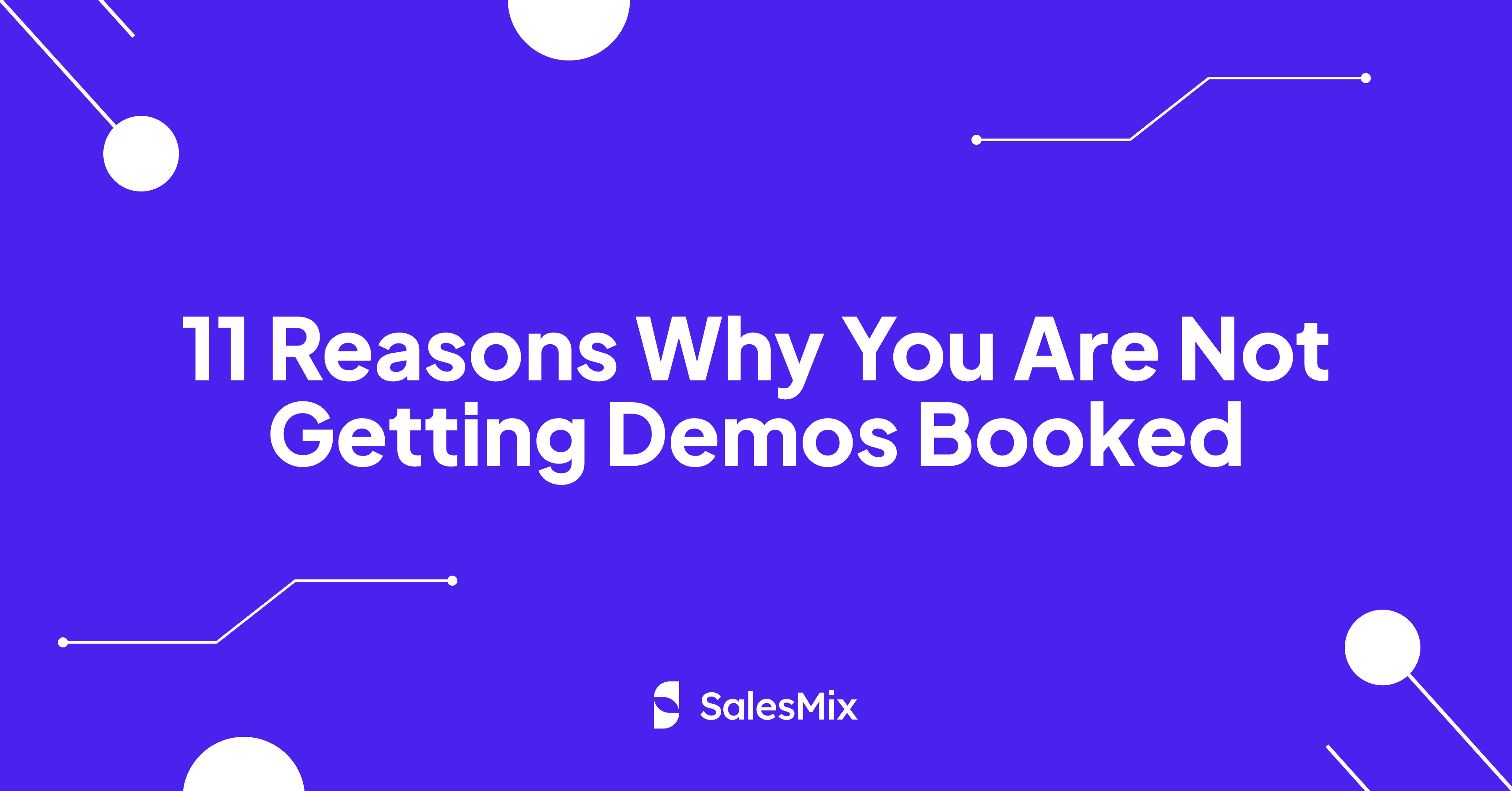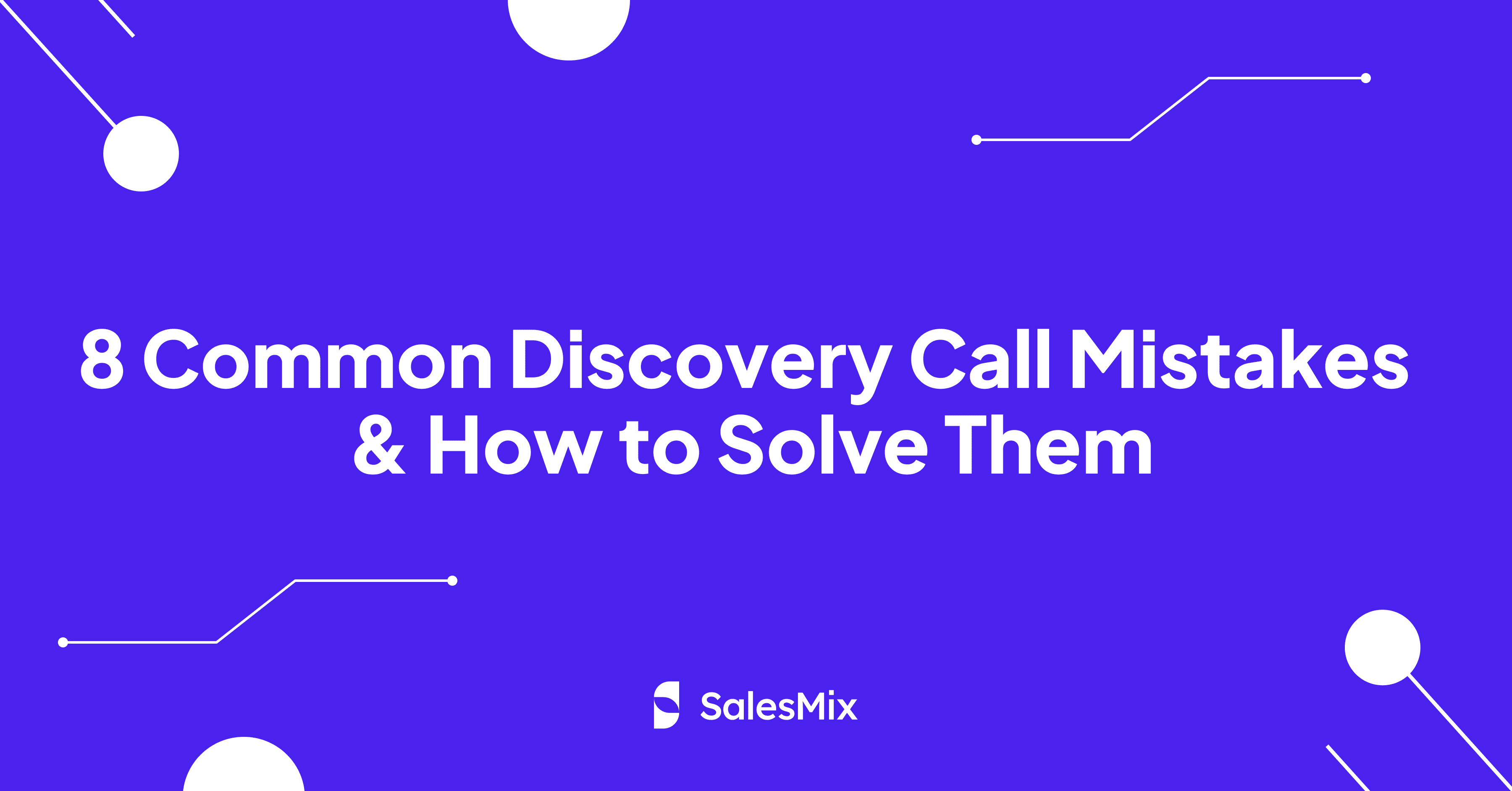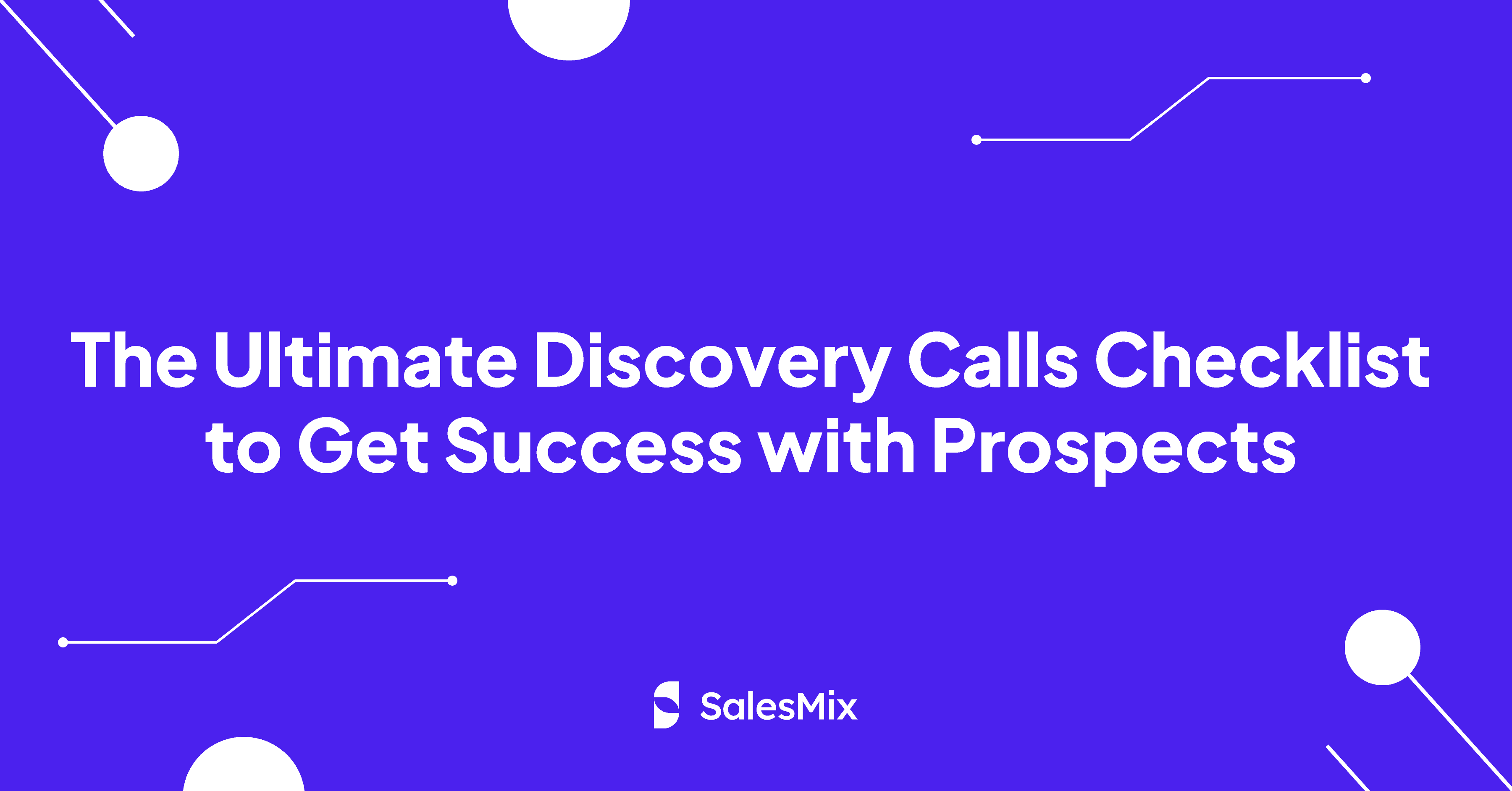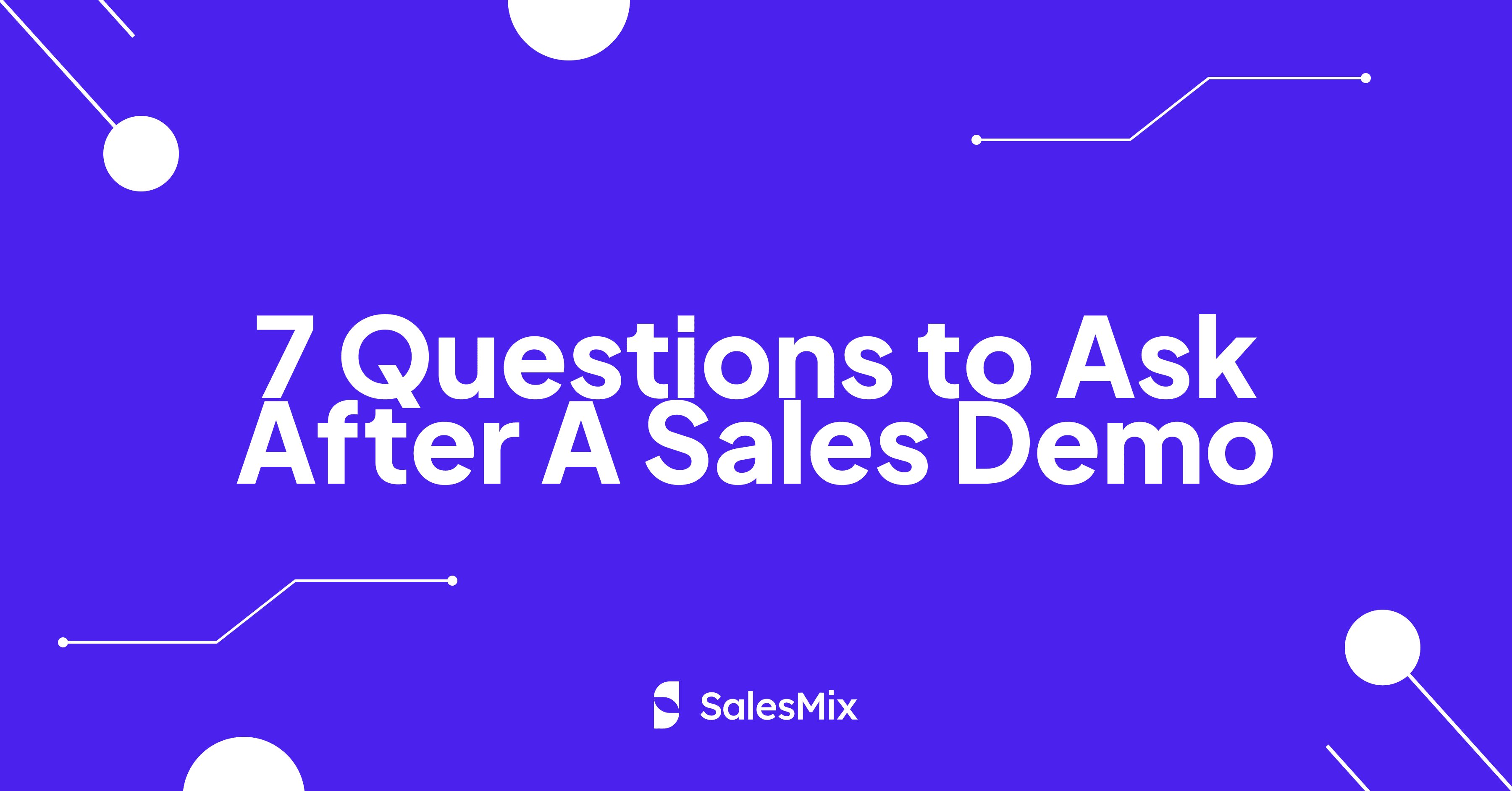Table Of Contents
As a B2B SaaS founder, you know that getting potential customers to book a demo is a critical step in your sales process. Yet, despite your best efforts, your demo calendar might not be as full as you’d like.
I know how frustrating it is when you’ve crafted compelling emails and developed a robust product, but you are not getting demos booked. Don’t you think it’s time to look back and think a bit? Shouldn’t we have an honest discussion on why this might be happening?
I will explore twelve key reasons why your demo bookings might be falling short and provide practical tips to help you turn those cold leads into confirmed demos.
Why is getting Demos Booked Important for Your Business?
If you’re running a B2B SaaS company, you already know that booking demos is crucial. But let’s dive into why it’s so important. As a founder, you must have spent countless hours developing a product you believe can change the game for your customers. The next step? Convincing potential clients of its value, and there’s no better way to do that than through a live demo.
Demos allow prospects to see firsthand how your solution can address their specific pain points. It is all about creating an experience where potential customers can visualize themselves using your product and reaping the benefits.
OneSpace’s study found that 88% of surveyed consumers said detailed product descriptions or interactive SaaS demos help them make better purchasing decisions. This underscores the importance of providing comprehensive and engaging product demos to facilitate informed decision-making to increase demo requests.
Moreover, according to OpenView, nearly 50% of SaaS companies offer a trial or freemium version of their product. This indicates a growing trend toward allowing potential customers to experience the product firsthand before committing.
In short, getting demos booked is a critical step in converting leads into loyal customers. It’s your chance to make a lasting impression, demonstrate value, and build trust.
What are The Most Common Causes of Not Getting Demos Booked?
Let’s hop on to the main reasons behind your offerings not getting the number of demo bookings they deserve.
1. Lack of Clarity on Target Audience Without an Ideal Customer Profile
It is becoming common to send out many cold emails for demo bookings, but the conversion rate doesn’t reflect the effort, right? It’s like casting a wide net in the ocean, hoping to catch a specific fish. Not having a clear Ideal Customer Profile (ICP) is often the culprit behind this scattergun approach.
Think about it: as a SaaS founder, your message can be razor-sharp when you know who needs your product. Imagine your software is a game-changer for small to medium-enterprise marketing teams using outdated tools. If your emails about this tool are landing in the inboxes of IT departments or large corporations instead of the mid-sized marketing teams, they’re likely just going to the spam.
Creating an ICP is about listing demographics and understanding potential customers’ specific challenges and needs. This understanding allows you to tailor your approach to speak directly to them, such as using terms they’re familiar with, addressing common pain points, and highlighting how your product can make their workday easier.
Remember, every email is a chance to talk directly to a potential early adopter of your technology. Don’t let that opportunity slip because you haven’t specified who that is. It’s like telling your friend about a solution before they realize they need it. That’s how you change the game.
2. Failure to Show The Actual Value You Provide
A common issue many SaaS founders encounter is failing to clearly articulate their product’s value in their initial outreach emails. This misstep can turn a potential hot lead cold faster than you can say “free trial.”
When you’re reaching out to potential customers, particularly through cold emails, your first goal is to grab their attention. But that’s just step one. The real challenge is immediately following that hook with a clear, compelling display of what your product does and why it matters specifically to them.
I reiterate that this step is not about boasting your features but about framing them as solutions to their pain points.
My friend, Laura, is running a SaaS company that helps e-commerce businesses streamline their inventory management. Initially, her emails focused heavily on the technical prowess of her software – things like real-time stock updates and predictive analytics. Impressive, right?
But her conversion rates were not looking impressive at all. It turned out that her potential clients wanted to hear less about the technology and more about how it would reduce overstocking costs and prevent revenue loss from stockouts. Her demo booking rates soared once Laura adjusted her messaging to highlight these tangible benefits.
In your cold emails, you need to quickly pivot from a brief introduction to what makes your product indispensable. Use language that resonates with the daily challenges your prospective clients face. If your software reduces operational time, tell them how they can use those saved hours to focus on scaling their business. Make it tangible, immediate, and undeniably relevant.
Remember, your goal is to make them think, “How have I been managing without this?” By the end of your email, they shouldn’t just understand what your product does—they should see it as the missing piece to their puzzle.
3. Poor Timing in Outreach Efforts
In the context of booking demos through cold email marketing, timing can make or break your engagement rates. It is more than avoiding the Monday morning rush or the Friday fade-out. It is about understanding the unique rhythm of your potential customer’s business day and aligning your outreach accordingly.
I started scheduling his email blasts using insights from analytics tools that showed when my prospects were most active online. Instead of a blanket morning mailout, I tailored my timing by timezone and individual activity patterns where possible. The results? My demo bookings doubled because I was catching leads exactly when they were most receptive.
So, when planning your next email campaign, think about the ‘when’ as much as the ‘what’ and ‘how’. You can utilize customer relationship management (CRM) software to glean insights into customer behavior or experiment with different times and days to see what resonates best with your audience.
Perfect timing does more than just increase the likelihood of your email being opened; it significantly boosts the chance of sparking a real conversation and getting a demo request. So, don’t let poor timing hinder your SaaS solution from showcasing its value.
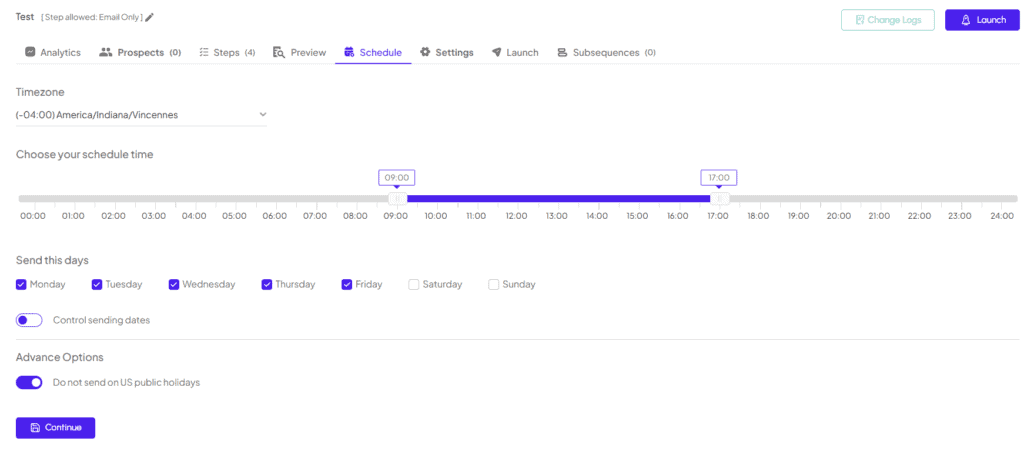
Automate your cold email campaigns by scheduling in SalesMix.
4. Ineffective Communication Leading to No Interest
Think about the last email you sent out aiming to book demos. Was it packed with jargon, or maybe it wandered around without getting to the point? It’s a common pitfall.
You know your product inside and out, and it’s tempting to dive deep into the specifics. However, your prospects might not be on the same page just yet. They need to understand what’s in it for them – and fast.
Use a conversational tone that resonates with your reader and keep the message simple and direct. Imagine you’re explaining your product to a friend who’s smart but not an industry insider. Try to avoid fluff or overly technical terms and clarify how your product makes daily operations smoother or more profitable.
Every email is an opportunity to spark interest and build a connection. So, before you hit send on your next demo booking email, ask yourself: “Does this sound like I’m talking to a friend about a solution they can’t afford to miss?” This approach can be useful in transforming your demo booking success.
5. Complicated Scheduling Process for Demos
You’ve surely been impressed by many new tools, and when you go to book a demo, you see that their demo scheduling process feels like navigating a maze without a map. I believe we are on the same page regarding the fact that a complicated scheduling process can be a major turnoff.
Let’s face it: as a SaaS founder, your goal is to make every interaction as smooth and efficient as your software claims to be. A clunky, time-consuming scheduling process contradicts that message when your prospects go to schedule a demo. Think about it this way: if prospective clients want to explore your product, why make them jump through hoops?
So, what do you need to do here? You have to ensure your scheduling process is as user-friendly as your product. Consider tools that allow one-click scheduling or provide immediate visibility into available time slots.
Don’t let a cumbersome scheduling process hinder your product and its potential users. Streamline your approach, and watch how a small change can significantly increase your demo bookings!
6. Unoptimized Landing Pages
Clicked on a link expecting to find exactly what you were looking for, only to land on a page with no clear direction? Well, it is a common pitfall for many companies where the landing page fails to convert enthusiastic leads into demo bookings. The reason? The page wasn’t optimized to guide the visitor to take that specific action.
Let’s consider your landing page for a moment. Is it cluttered with too much information, or does it have too many calls to action that overwhelm the visitor? Maybe it’s not clear enough about what the visitor should do next. These elements can significantly deter potential customers from signing up for a demo despite their initial interest.
It will lead to a situation like this – you’ve done a great job crafting a compelling cold email. The recipient clicks the link, fueled by curiosity and a genuine interest in your product. However, upon arriving at your landing page, they are bombarded with various options and no clear path to booking a demo. Chances are, they might click away, lost to confusion.
So, your landing page must be a seamless extension of your cold email’s promise and as inviting and intuitive as possible. It needs to be clean, focused, and centered around one primary call to action – booking a demo.
7. Inadequate Lead Qualification Processes
Let’s talk about something that might be tripping up your demo booking process before you even get to showcase your SaaS product: inadequate lead qualification. This is a critical step that, if overlooked, can have you spinning your wheels with prospects who may not be the right fit for your service or, worse, aren’t ready to make any decision yet.
Imagine you’re a fisherman casting your net. Would you fish in waters where your target fish don’t swim? It sounds silly when put like that, but that’s essentially what happens when you don’t qualify your leads properly. You end up spending valuable time on prospects that don’t align with the customer profile you actually serve.
I once worked with a team that struggled to convert the leads into demo participants. The team was doing fine in reaching a broad spectrum of businesses. However, many did not have the infrastructure to implement or benefit from her product. After refining the lead qualification process to target only those businesses with the necessary systems and pain points, the team’s demo bookings increased, and the conversations during these demos became much more productive.
You can integrate a lead scoring system that helps you determine which prospects are most likely to benefit from and purchase your product. You can score leads based on specific criteria such as industry, company size, technology use, and even engagement with your previous marketing efforts.
8. Insufficient Follow-Up Strategies
You may even get a decent response after you send out your initial batch of emails. A few prospects even show keen interest. But then, life happens. Emails get buried under new ones, meetings pop up, and your prospect’s attention drifts away. These initially warm leads can quickly cool off without a solid follow-up plan.
Think of it as watering a plant. You wouldn’t just water it once and expect it to thrive forever; it needs regular care. Similarly, your leads need nurturing. A follow-up email or call a few days after the initial contact keeps the conversation alive and shows your prospects that you value their interest genuinely.
This is true regarding whether there is interest or a lack of attention from your recipient from the first email. You need to remind them to continue the dialogue and deepen the relationship.
Your follow-up doesn’t have to be complex. It should reaffirm the value you offer, reflect an understanding of the prospect’s needs, and include a clear, easy action step to take. Whether it’s a scheduled follow-up call, a demo reminder, or additional content that speaks to their pain points, make sure it feels personal and timely to persuade the prospects to request a demo.
9. Lack of Personalization for The Audience
You know the feeling: you receive a generic email, and within seconds, it’s deleted. This is exactly what happens when your outreach lacks personalization. Let’s say you’re targeting marketing managers at mid-sized tech companies. A one-size-fits-all email won’t cut it. They need to see that you’ve taken the time to understand their industry, their specific pain points, and how your solution can uniquely address those issues. It requires a message that resonates deeply with their daily struggles and goals.
I remember a conversation with Mark, a fellow SaaS founder who was struggling with demo bookings. His initial strategy was to send out broad emails highlighting his product’s features. Unsurprisingly, this approach fell flat. After shifting to a personalized strategy, where he tailored each email to reflect the recipient’s industry and specific pain points, he saw a dramatic increase in responses and demo bookings. He didn’t just say, “Here’s what my product does.” He said, “Here’s how my product solves the exact problem you’re facing.”
Before sending your next email batch, take a moment to personalize your outreach by researching your ICP. It’s a small step that can make a huge difference in your demo booking rates. After all, in a crowded inbox, a personalized message is what makes you stand out.
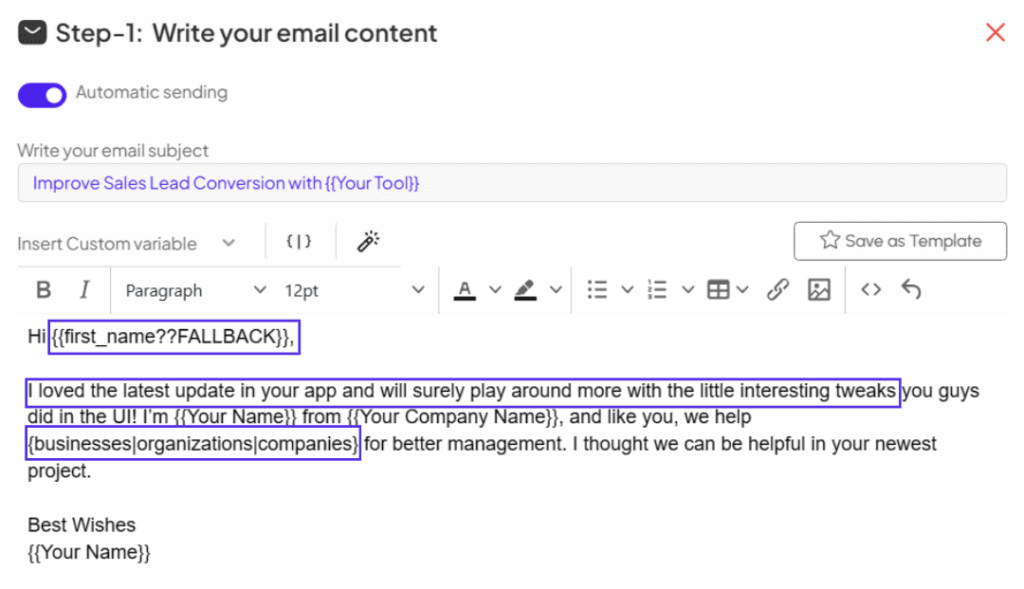
Personalization in SalesMix.
10. Lack of Trust Signals
Imagine receiving a cold email that piques your interest, but as you skim through it, you notice a glaring absence of any trust signals. No testimonials, no case studies, and no recognizable client logos. You’d likely hesitate to engage further, right?
Trust is the foundation of any successful business relationship. In the B2B SaaS world, where you’re asking potential clients to invest time in a demo, establishing credibility from the get-go is crucial.
You should start by showcasing testimonials from satisfied clients to build trust. Real quotes from real people can make a world of difference. If possible, include case studies highlighting measurable results your customers achieved. Don’t forget to display logos of well-known companies that use your product. These elements collectively create a sense of reliability and professionalism.
Trust signals on the SalesMix website.
Another practical tip is to include links to third-party reviews or awards your company has received. It says out loud that your product is appreciated and meets industry standards.
11. Weak Calls-to-Action
You’ve put together a fantastic email showcasing your SaaS product, but the demo bookings aren’t rolling in despite all your efforts. One often overlooked reason? Weak calls-to-action (CTAs).
A CTA is more than just a button at the end of your email, as it can be the pivotal moment where you guide your prospect to take the next step. If your CTA lacks clarity and urgency, it can leave potential customers in limbo, unsure of what to do next.
Think about your favorite online stores. You know exactly what to do when you see a clear, compelling “Buy Now” button. The same principle applies to booking demos. Your CTA needs to be direct and persuasive, leaving no room for hesitation or confusion. You have to say more than, “Let me know if you’re interested.”
Make it easy for your prospects to take that next step. Include direct links to your scheduling tool, ensuring that booking a demo is just a click away. The easier and more intuitive the process, the more likely they will follow through.
How can SalesMix Help You Get More Demos Booked
As a B2B SaaS founder, you understand the critical importance of booking demos and want to do as much as possible for them. However, managing the intricacies of cold email marketing can be daunting. This is where SalesMix comes in. SalesMix offers a suite of tools designed to streamline your email campaigns and enhance their effectiveness to ensure more demos.
It automates your email sequences and lets you focus on other aspects of your business. Suppose you’ve identified your target audience and crafted the perfect email. With SalesMix, you can automate the sending process. Once you set up a sequence, SalesMix sends out the initial email at the optimal time, eliminating the need for manual intervention.
But it doesn’t stop there. We’ve seen how crucial follow-up emails are for establishing the proper ground for booking demos. Prospects often need multiple touchpoints before they commit to a demo. SalesMix allows you to schedule these follow-up emails with specific attributes, such as the number of days between emails. This contextual approach keeps your service top-of-mind for your prospects without overwhelming them.
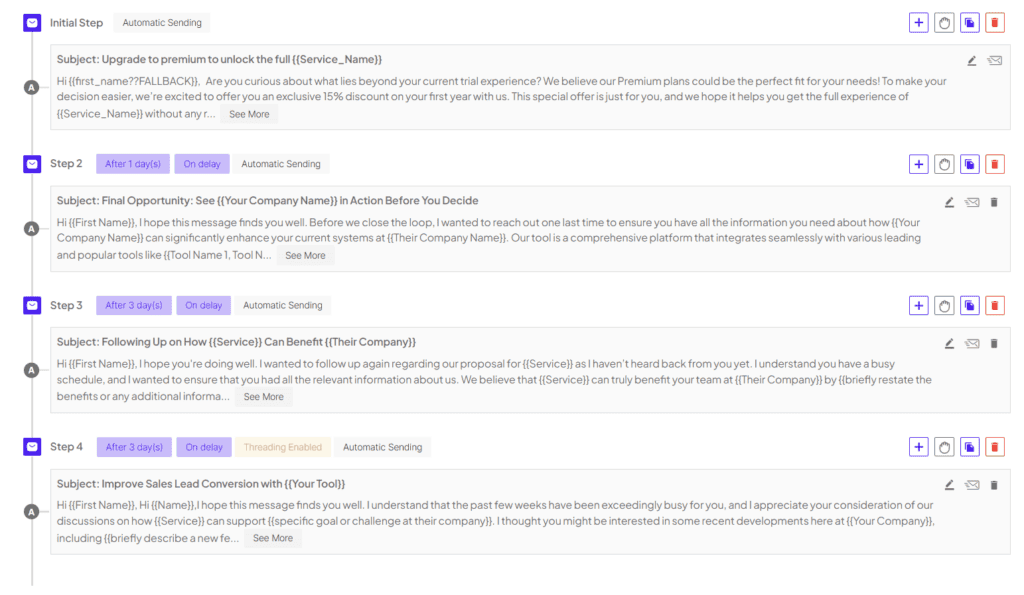
Follow Up Emails Scheduled in SalesMix.
Another standout feature of SalesMix is its advanced personalization capabilities. You can integrate data from your CSV files to dynamically insert personalized content, such as the recipient’s first name or specific details about their workplace. This level of personalization makes your emails feel more tailored and relevant with SalesMix.
Timing is everything when you’re running behind those valuable demos. SalesMix enables you to schedule emails at opportune times by aligning with your recipients’ time zones. It ensures your emails land in inboxes when they are most likely to be read. With this feature, you can also prevent emails from being sent on US public holidays.
SalesMix addresses any issue of email deliverability with its automated warm-up service. With just a single button press, you can activate this feature, which helps to ensure that your emails are not flagged as spam. Pre-send testing is also available to confirm that your emails are landing in inboxes rather than spam folders
Conclusion
Booking more demos is essential for the growth and success of your B2B SaaS company. As we’ve explored, there are several critical reasons why you are not getting demos booked as per your expectations. From not having a clear Ideal Customer Profile (ICP) and failing to articulate your product’s value to poor timing and ineffective follow-up strategies, each factor can significantly affect your outreach effectiveness.
Addressing these issues head-on, you can transform your approach and significantly increase your demo bookings. You should consider each interaction as an opportunity to showcase the unique value of your solution.

